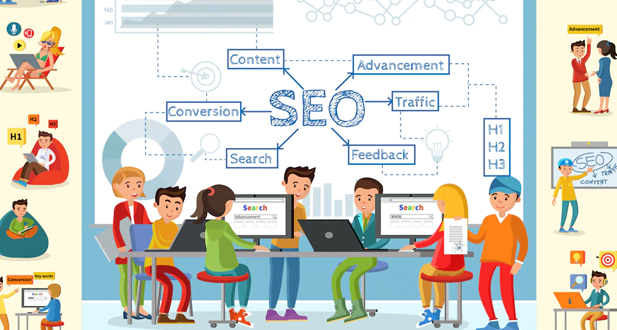Conversion Rate Optimization:
Conversion Rate Optimization (CRO) is a successful digital marketing strategy that helps maximize organic website traffic and increase the percentage of visitors who convert into paying customers.
It involves website personalization, search engine optimization, and more to help achieve meaningful growth. CRO has distinct benefits when compared to other digital marketing strategies as it helps produce better results with fewer resources.
By optimizing your website for conversion rate optimization you can increase the percentage of website traffic that converts into paying customers resulting in more sales or leads with less money spent on marketing campaigns.
CRO is an important part of any digital marketing strategy and should be used if you want to achieve meaningful growth without increasing your budget significantly.

With proper implementation, you can expect a significant improvement in conversion rate and an overall better result from your digital marketing efforts.
Conversion rate optimization (CRO) is the process of optimizing website visitor behavior to increase active users and convert passive website visitors into customers.
It involves creating a better overall landing page experience and providing contact details, desired actions, and other relevant content that encourages website visitors to take action.
A beginners guide to CRO can help you understand how to optimize your landing pages in order to increase the percentage of website visitors that convert.
This can be done by creating attractive, interactive content, improving load times, providing clear calls-to-action or even using A/B testing to determine which changes are most successful in converting passive website visitors into paying customers.
Conversion Rate Optimization (CRO) is an iterative process of analyzing user experience and visitor behaviors to find the best ways to increase conversion rates.
This process can take some time, but it is worth it, as consistent increases in conversion rates can lead to a significant increase in a website’s revenue.
It’s all about creating that ‘aha’ moment for visitors – you want them to feel like they understand your product or service and that what you offer meets their needs.
That’s why many online companies are now focusing on Conversion Rate Optimization (CRO). This is a digital marketing practice that uses various optimization campaigns to increase website conversion rates and better revenue.
By optimizing your website, you can help ensure that more of your traffic converts into paying customers. Through CRO, you can get more out of your existing traffic by increasing the rate at which visitors turn into leads and customers.
This means that with the same amount of website traffic, you could potentially see an uplift in revenue as well as a better return on investment (ROI).
Additionally, CRO allows you to test different elements on a page such as copy or color scheme to find what works best for your target audience – helping to make sure they’re getting the best experience from their visit and helping convert them into customers.
In conclusion, Conversion Rate Optimization is an incredibly valuable tool for increasing website revenue without necessarily having to invest in additional traffic or resources.
With effective rate optimization techniques implemented correctly, companies can expect to see improved conversions and higher ROI over time.
Conversion Rate Optimization (CRO) starts with a conversion funnel and specific conversion goals. This helps to identify where in the marketing funnel users are dropping off, so that optimization efforts can be focused on those areas.
Conversion rate analytics dashboards are then used to track the success of each landing page and click landing. Google Analytics is a great tool for tracking conversions, but other tools may be necessary to maximize optimization efforts.
How do you optimize Conversion Rate:
Optimizing your website for conversion rate optimization is essential to improve conversions and achieve meaningful growth. A few optimization techniques businesses can adopt are website personalization, sponsored search ads, and optimizing product pages. Website design is the foundation of conversion rate optimization:
overall website design and product pages especially need to be optimized in order to raise your conversion rate. Ads and landing pages should also be optimized, as they are key elements of a successful optimization strategy.
Through experimentation with personalization, businesses can see better results and achieve meaningful growth.
Website optimization and boost marketing efforts are key to improving your business. Working with optimization services can become the ultimate conversion rate optimization, turning visitors into customers.
Business conversion is the main goal of any website and improving site performance is one of the most important tasks. To navigate your website correctly, mapping out the importance of each page in relation to leads, revenue and sales is paramount.
This should be combined with speed optimization as well as interaction optimization to ensure that users have a positive experience when they interact with your business page. The more sales you make, the higher will be the revenue generated from your website.
To do this, you need to optimize your conversion rate. This can be done through an informed optimization process. Conversion rate optimization (CRO) requires you to use insights, best practices and customer behavior insights to create a website landing page that increases the probability of website visitors taking desired action.
The goal is to increase the percentage of visitors who take the desired action. To determine what works best for your particular business, look at past user behavior and identify which actions lead to the most conversions.
Experience optimization process plays an important role in optimizing your website for conversions, as it allows you to understand how users are interacting with your site.
This optimization methodology can provide incredible results for your business, as it helps boost your number of conversions and leads customers to take action.
It also helps reduce lower acquisition costs and provides a birds eye view of the process that allows you to obtain greater value from users. When done correctly, rate optimization can help you achieve incredible results and increase overall profitability.
A strong conversion rate uplifts revenue and helps you to maximize the ROI of your digital marketing work. Conversion rate optimization is an effective way to help digital marketing clients, businesses and agencies increase their conversion rates.
The first step in helping a business optimize its conversion rate is to visualize the user’s journey on their website. Digital marketing agencies should take a look at how users interact with products, pages and other elements of the website by using user testing or analytics tools.
By understanding how users interact with the site, agencies can better understand what changes need to be made that will benefit their own websites as well as those of other agencies they work with.
Once you understand user behavior, you can start designing optimization campaigns that target areas of your website that lead to higher conversions since conversions are where money is made.
This could include anything from redesigning product pages, making navigation easier or adding call-to-action buttons in key locations.
What is CRO vs SEO:
Cro (Conversion Rate Optimization) and SEO (Search Engine Optimization) are two distinct processes that have many ways of helping you to increase organic website traffic.
Cro is focused on increasing the conversion rate of visitors, while SEO is focused on increasing your rankings in search engine results. Both of them have different objectives, but they can be used together to maximize your marketing budget.
With Cro, the main objective is to get more conversions from the same amount of website traffic by testing different elements such as page design, copywriting etc.
Whereas with SEO, it focuses more on optimizing your website so that it ranks higher in search engine results and drives more organic traffic to your website.
Cro vs SEO is a comparison between conversion rate optimization (CRO) and search engine optimization (SEO). It is important to understand how these two strategies differ as they each play an integral role in increasing sales.
Conversion Rate Optimization (CRO) focuses on improving the rate at which visitors convert into customers. This means optimizing website elements, such as calls-to-action, images, fonts, and more to increase the number of conversions.
Rate Optimisation helps businesses maximize their online presence by using data to find ways to better engage with potential customers.
Digital marketers’ job is to ensure that businesses are able to maximize their digital experience optimization, and they do this by making use of CRO experts and SEO experts.
Conversion Rate Optimization (CRO) is the process of increasing conversions on a website or landing page by better understanding customer needs and behaviors.
It is a tremendous opportunity for digital marketing because it can help increase conversions, traffic, clicks and sales.
Cro Vs Seo is a comparison of two different methods of optimizing a website for search engine visibility. SEO stands for Search Engine Optimization, and it is the practice of optimizing websites to appear higher in the rankings of search engines.
CRO stands for Conversion Rate Optimization and involves focusing on user experience on websites to increase conversions. Both SEO and CRO are important parts of any digital marketing strategy because they help businesses get found by potential customers as well as convert those customers into leads or sales.
By focusing on both, businesses will be able to increase their online presence, reach more users and build their customer base.
CRO (conversion rate optimization) and SEO (search engine optimization) are two of the most important marketing levers when it comes to optimizing your website for search engines.
CRO focuses on increasing the conversion rate of website visitors. This involves making sure that page speed is optimal, content is relevant to the user’s search intent, and there are clear calls-to-action on each page.
Additionally, optimizing category pages for better organic rankings can help businesses drive more sales from their target audience. SEO, on the other hand, focuses on keyword optimization and improving a website’s visibility in search engine results pages (SERPs).
This involves creating content that resonates with users and ensuring all meta tags are properly optimized for maximum visibility in SERPs. Additionally, implementing schema markup can help boost organic rankings even further.
By utilizing both CRO and SEO techniques together, businesses will be able to increase their website ROI by improving their conversation rate as well as increasing their organic traffic from search engines.
With these two techniques combined, businesses will be able to benefit greatly from increased visibility in SERPs while also converting more site visitors into customers or leads than ever before
Why to use Conversion Rate Optimization:
Conversion rate optimization (CRO) is a key part of any successful online marketing campaigns. It involves optimizing website visitors and landing pages to increase the percentage of users that convert into customers.
By optimizing the different elements on your webpage, you can ensure that many visitors become paying customers. CRO helps you identify areas where you can improve your website so it will be more likely to convert users into customers.
You can also use it to identify which social channels are driving the most conversions for your business and make sure that you’re targeting those channels with the most effective content.
CRO helps you get maximum value from each visitor by increasing the number of conversions from each user, resulting in higher ROI for your online marketing campaigns.
With CRO, you can target website visitors, page visitors and website traffic to increase the number of conversions.
It helps you optimize your digital marketing campaigns by converting new visitors as well as previous visitor pools into customers or leads. By using CRO, businesses can lower their conversion rate over a longer period by optimizing their website for better performance.
This will ultimately lead to an increase in the number of conversions and overall ROI for your online marketing efforts.
Conversion rate optimization (CRO) is the process of optimizing a website to convert more visitors into leads, customers and sales. It helps to maximize the return on investment of your website traffic by analyzing customer journeys and taking steps to improve it.
CRO will help you get more out of your marketing campaigns, as well as optimize your search engine rankings and gain organic visibility in SERPs. With good CRO effort, you’ll see that all your marketing efforts bring lots of high-quality traffic results in terms of qualified leads and sales for an online store.
By optimizing the customer journey on a website, businesses can realize higher revenue from their marketing efforts with minimal effort.
Conversion rate optimization (CRO) is a powerful tool that helps websites maximize conversions by increasing the percentage of website visitors who convert from casual browsers to paying customers.
A robust CRO program can help businesses increase conversion rates by optimizing web pages and creating relevant landing pages to drive more traffic and higher conversion rates.
With consistent increases in conversions, businesses can lower their customer acquisition costs (CAC). Ultimately, a successful CRO program will increase the total number of conversions and help improve the overall profitability for a business.
To get started with rate optimization, businesses should focus on creating relevant landing pages, optimizing their webpages for better user experience and tracking key performance indicators in order to measure success over time.
By using conversion rate optimization techniques, businesses will be able to see consistent increases in their website’s conversion percentages while also lowering CAC costs and increasing total revenue.
Conversion rate optimization campaigns are a great way for digital marketing agencies to increase customer loyalty, improve customer service requests, and ultimately uplift revenue.
Agencies gain revenue through this optimization process by increasing the effectiveness of their current customers and gaining new customers.
With a better ROI, conversion rate optimization also helps to create an overall good experience for the customer.
Digital marketing is all about optimizing websites and campaigns in order to get the most out of every visitor that comes to your website.
Conclusion:
Conversion Rate Optimization (CRO) is a critical component of any digital marketing strategy. It involves analyzing user behavior on a website or mobile app and making changes to improve the likelihood of converting visitors into customers or achieving other desired outcomes, such as sign-ups or downloads.
Effective CRO requires a deep understanding of user behavior, careful analysis of data, and a willingness to experiment and iterate on website design and messaging. By continuously refining and optimizing a website’s conversion funnel, businesses can increase their ROI and drive more revenue from their online presence.
Overall, CRO is a valuable investment for any business looking to maximize the impact of their digital marketing efforts and improve their bottom line.
Frequently Asked Questions
Some CRO techniques include A/B testing, multivariate testing, user testing, heat mapping, conversion funnel analysis, and optimizing page load times.
Some benefits of CRO include increased conversion rates, improved user experience, better engagement, increased ROI, and more effective use of marketing budgets.
The time it takes to see results from CRO can vary depending on the complexity of the website and the scope of the changes being made. However, some changes can produce results quickly, while others may take longer to implement and test.
Yes, CRO can improve SEO by increasing engagement metrics such as time on site, bounce rate, and click-through rate. These metrics can signal to search engines that the website is providing value to users, which can help improve its ranking in search results.
No, CRO is an ongoing process that involves continuous analysis and refinement of website design and user experience to improve conversion rates and achieve better results.



